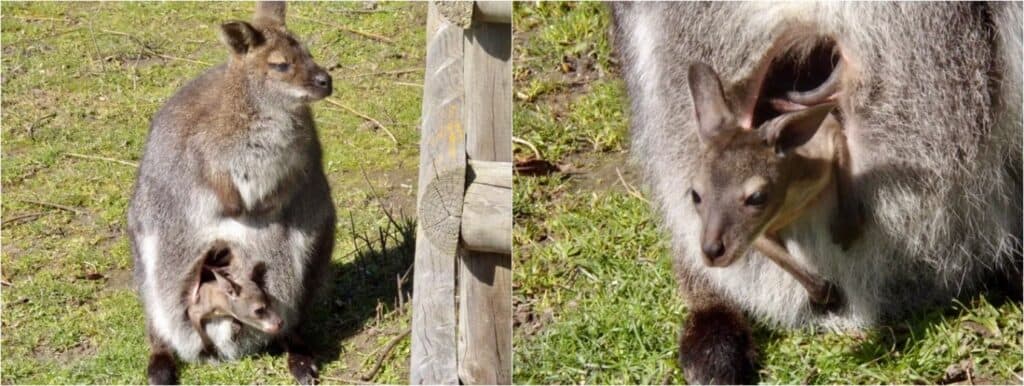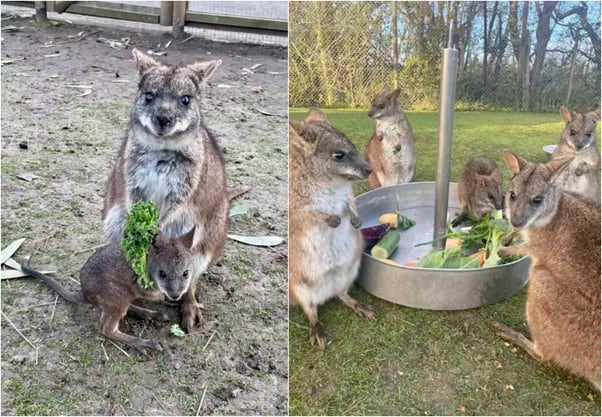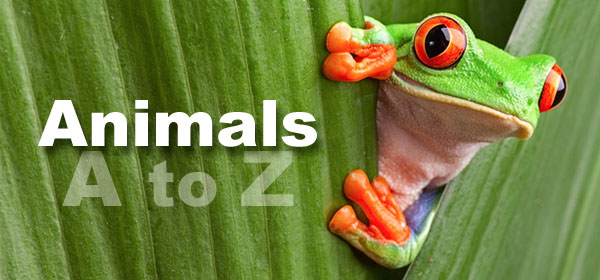Hello! As a newer member of the mammal keeper team here at Wingham Wildlife Park, one of my favourite parts of the job is getting to learn new things about the animals I work with everyday. With the recent births of three adorable Bennett’s wallaby joeys at the park, I wanted to dive deeper into the world of wallabies and other marsupials.

One of our Bennett’s wallabies with her joey.
What is a Marsupial?
You’re probably most familiar with a group of mammals called placentals, which encompasses many species ranging from giraffes, tigers, elephants, and humans. Placental mammals are named as such because they grow complex placentas during pregnancy which provide nutrients to foetuses for a prolonged period of time, meaning babies are born at a more developed stage. In contrast, marsupials create simpler placentas which supply limited nutrients, and so their pregnancies are much shorter and the babies, called joeys, are born small and underdeveloped and instead do most of their growing in an external pouch. For example, adult Bennett’s wallabies grow to around 14-18kg, but the newborns weigh less than a gram – that’s the equivalent of a human giving birth to a baby the size of a sugar cube! Despite being born so tiny (as well as blind and deaf), new born joeys crawl unaided from the birth canal to the mother’s pouch where they feed from a teat and continue developing for several months. Now that’s willpower…
What Animals are Marsupials?
Marsupials make up less than 10% of all mammal species, and more than half of them are native to the continent of Australia due to its separation and isolation from other landmasses millions of years ago. Well known marsupials include kangaroos, wallabies, possums, wombats, and koalas, although you don’t need to travel all the way to Australia to find marsupials as we have several at Wingham!
Bennett’s Wallabies
These are the largest Australian wallaby, similar in weight to a medium-sized dog. They can be found in a variety of habitats across the East coast and South of Australia as well as Tasmania, such as eucalyptus forests, grasslands, and woodlands. While predominantly solitary, these wallabies form groups in areas where food is abundant, and will breed primarily during the summer when resources are high. Males fight one another by boxing to gain dominance and access to females who are pregnant for only four weeks. Joeys develop in the pouch for an extra nine months, although they will exit and re-enter the pouch up to around 17 months of age for milk and warmth. Our Bennett’s wallabies are housed in the old horse paddock, near the moon bears.

Parma Wallabies
On the other end of the scale, these are the tiniest Australian wallaby, weighing 5kg on average, which is about the size of a house cat. Parma wallabies are native to Eastern Australia, living in subtropical rainforests and wet sclerophyll forests where there is dense vegetation to eat. Like other wallabies, they are solitary and naturally shy, but they gather to feed and mate. Males also engage in boxing-like fights, although they’re a lot less intimidating! While the gestation period of females is similar between these two wallaby species, parma wallaby joeys only stay in the pouch for 5-6 months instead of nine. We currently have two groups of parma wallabies; our female group is located next to the goats, and our male group is in a mixed-species enclosure with the black and white ruffed lemurs. They are separated to stop breeding, as they reproduce faster than we keepers can keep up with!

Sugar Gliders
These cute creatures are a species of gliding possum which inhabit forests in several countries such as Australia and Papua New Guinea. They live in small mixed-sex colonies of approximately 5-12 individuals where one or two dominant males reproduce with all females in the group. Males gain dominance primarily through scent marking, producing a smelly musk from several scent glands, including one on the forehead which resembles a bald spot! Females are pregnant for only a fortnight, and their joeys are born the size of a grain of rice, growing in the pouch for around two months. Once they are old enough, juvenile gliders exit the pouch but will cling on to their mother’s back until they learn to glide and forage for themselves. You can find our sugar gliders in the Nocturnal House – keep an eye out for them in the dark!

Unique Advantages of Marsupial Reproduction
The breeding behaviours of marsupial species have several benefits. Firstly, their short gestation times mean females expend less energy during pregnancy as they aren’t required to carry a heavy foetus internally. This is especially important in areas like Australia where resources often fluctuate. Furthermore, short pregnancies reduce the likelihood of complications such as the immune system rejecting the embryo. The development of a baby in an external pouch is also advantageous, as the mother can eject and abandon her baby in times of extreme stress, such as predator attacks. This has been observed primarily in species like kangaroos and wallabies, and increases the mother’s chance of survival so she is able to breed again once conditions stabilise. Nature is sometimes brutal! This is helped by the fact that marsupials can become pregnant very quickly after giving birth, and some can even pause the development of the embryo, known as embryonic diapause. This means females can wait for the joey currently in the pouch to mature before beginning her next pregnancy, or even wait for better conditions like stable food and shelter to maximise the likelihood of her offspring’s survival. The reproductive flexibility of marsupials is truly fascinating and makes them some of the most adaptable and resilient mammals out there.
Conclusion
Thank you for reading my first blog! As part of our keeper for a day experience you can get up close and personal with one of our marsupials, the parma wallabies. Also, if you look closely, you may spot a Bennett’s wallaby joey peeking out of its pouch on your next visit!
By Mammals Keeper, Ella


